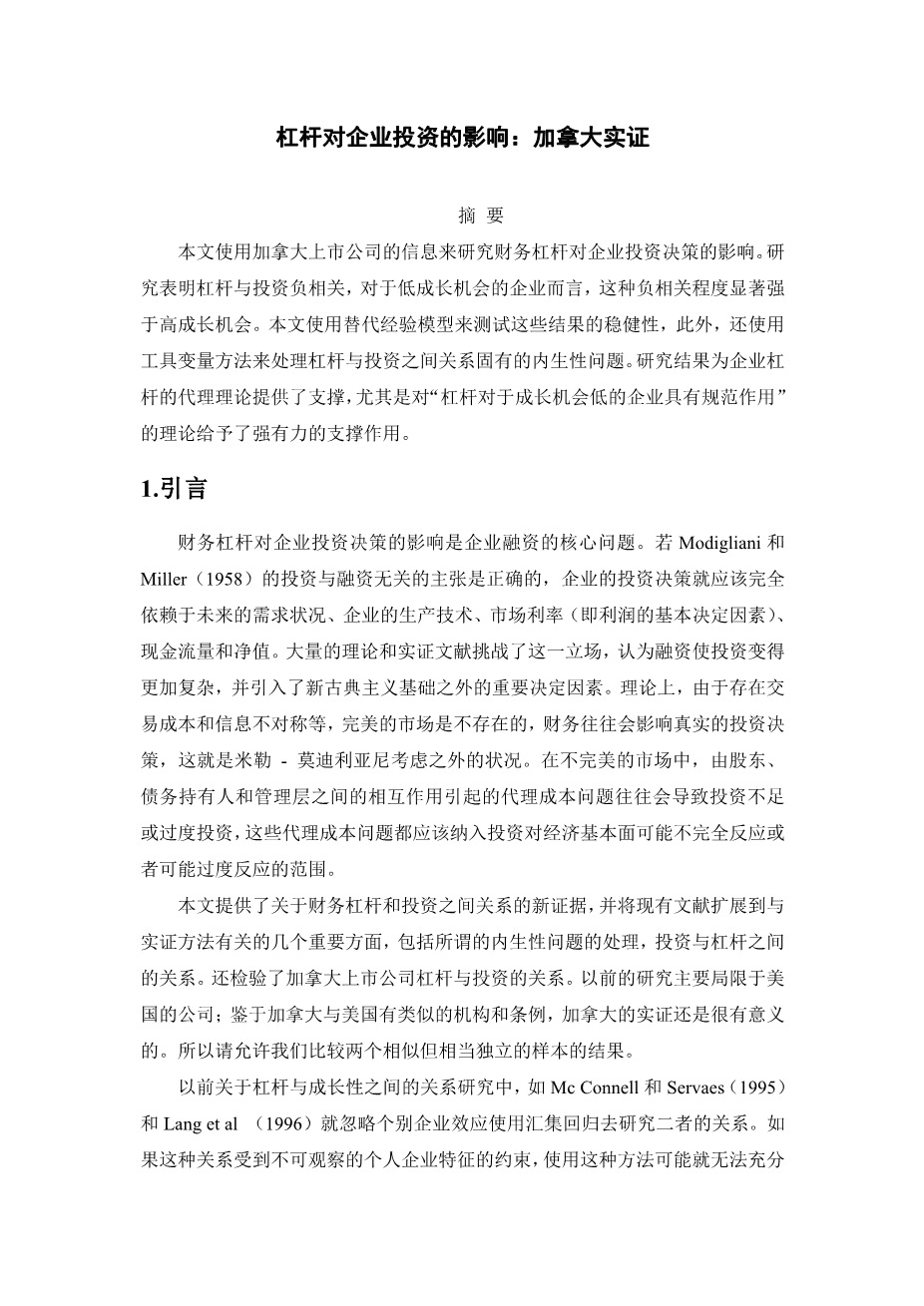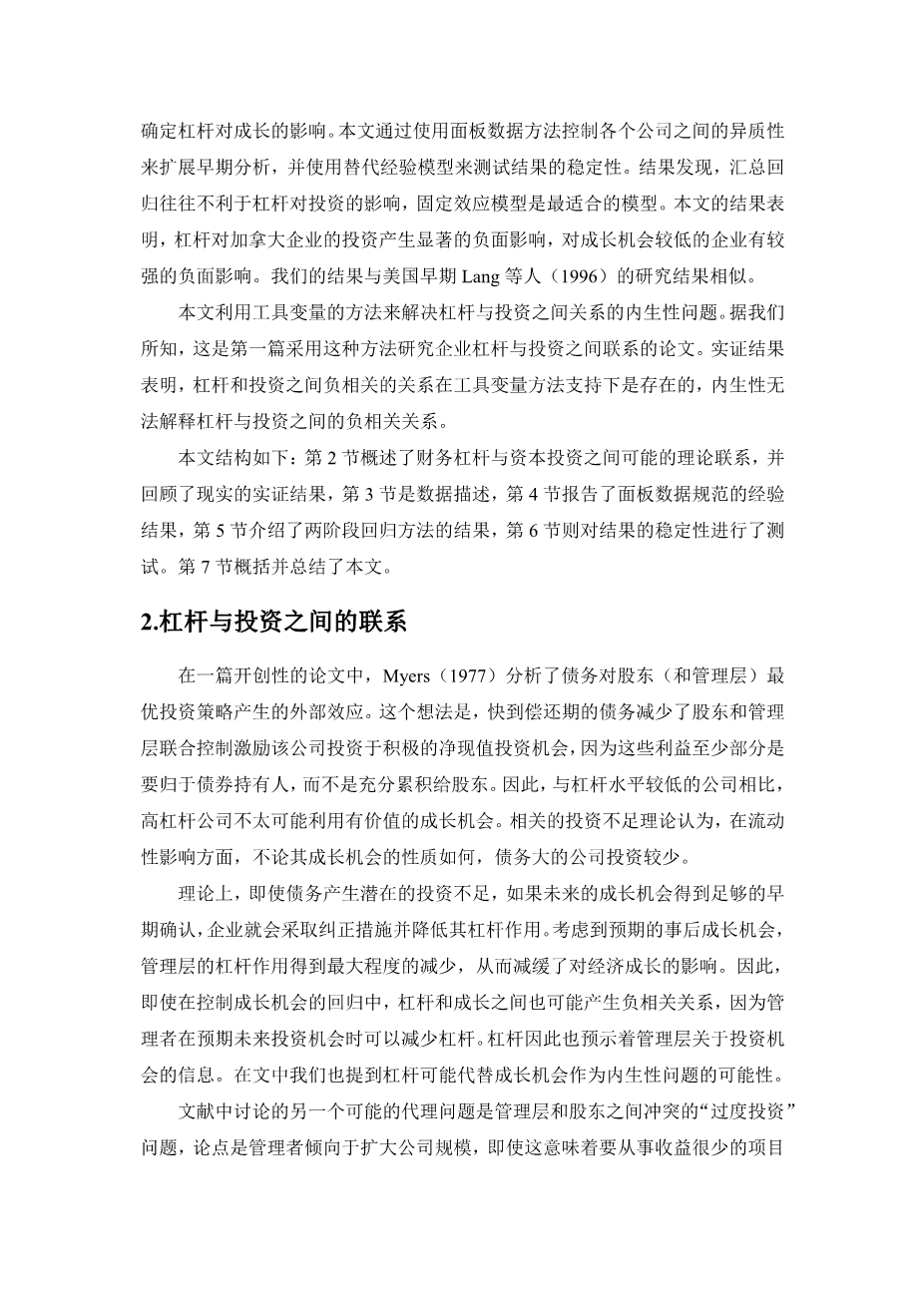The impact of leverage on firm investment: Canadian evidence
Varouj A. Aivaziana,*, Ying Geb*, Jiaping Qiuc
a Department of Economics and Rotman School of Management, University of Toronto, 150 St. George Street,Toronto, ON, Canada M5S 3G7
b School of International Trade and Economics, University of International Business and Economics,Beijing, P.R. China
c Finance Area, School of Business and Economics, Wilfrid Laurier University, 75 University Avenue West,Waterloo, ON, Canada N2L 3C5
Abstract
This study examines the impact of financial leverage on the firms’ investment decisions using information on Canadian publicly traded companies. It shows that leverage is negatively related to investment and that this negative effect is significantly stronger for firms with low growth opportunities than those with high growth opportunities. The paper tests the robustness of these results using alternative empirical models and, in addition, uses the instrumental variable approach to deal with the endogeneity problem inherent in the relationship between leverage and investment. The results provide support to agency theories of corporate leverage, and especially the theory that leverage has a disciplining role for firms with low growth opportunities.
Keywords: Leverage; Investment; Canada; Corporate finance.
1.Introduction
The impact of financial leverage on a firm’s investment decision is a central issue in corporate finance. If the Modigliani and Miller (1958) irrelevance proposition is correct, a firm’s investment policy should depend solely on such factors as the future state of demand, the firm’s production technology, the market interest rate, that is, on fundamental
determinants of profitability, cash flow, and net worth. A large theoretical and empirical literature has challenged this position, arguing that financing considerations significantly complicate the investment relationship, introducing important determinants beyond neoclassical fundamentals. In theory, finance tends to affect real investment decisions when there are missing or incomplete markets due to transaction costs and asymmetric information—that is, outside a Miller – Modigliani world.1 In a world with incomplete markets, agency problems arising from interactions between shareholders, debt holders, and management give rise to under-investment or over-investment incentives; these agency problems introduce a range in which investment may not be fully responsive, or may be over-responsive, to changes in economic fundamentals.
The present paper provides new evidence on the relationship between financial leverage and investment and extends the prior literature in several important dimensions pertaining to empirical methodology, including the treatment of the so-called problem of endogeneity, in the relationship between investment and leverage. It examines the relationship for Canadian publicly traded companies. Previous studies have been mostly restricted to firms in the United States; Canadian evidence is of particular interest given that Canada has similar institutions and regulations to the United States. This study allows us to compare results across two similar yet quite independent samples.
Previous studies of the relationship between leverage and growth, such as McConnell and Servaes (1995) and Lang et al. (1996), use pooling regressions and in effect ignore individual firm effects. Such an approach may not fully identify the impact of leverage on growth if the relationship is also governed by unobserved individual firm characteristics. This paper extends the earlier analyses by using a panel data methodology to control for heterogeneity among individual firms, and tests the robustness of the results using alternative empirical models. It finds that a pooling regression tends to underestimate the impact of leverage on investment and that the fixed-effects model is the most appropriate specification. The results of the paper indicate that leverage has a significantly negative impact on investment for Canadian firms and that it has a stronger negative impact on firms with low growth opportunities. Our results are similar to earlier ones for the US, such as those of Lang et al. (1996).
This paper utilizes the instrumental variable approach to address the endogeneity problem pertaining to the relationship between leverage and investment. To our knowledge, this is the first paper that employs this approach to study the link between leverage and firm investment. The empirical results indicate that the negative relationship between leverage and investment is maintained under the instrumental variable approach suggesting that endogeneity cannot explain away the negative relationship between leverage and investment.
The paper is organized as follows. Section 2 outlines possible theoretical links between financial leverage and capital investment and reviews extant empirical results. Section 3 describes the data and Section 4 reports the empirical results from a panel data specification. Section 5 presents results from a two-stage regression approach, while Section 6 tests the robustness of the results. Section 7 summarizes and concludes the paper.
2.The link between leverage and investment
In a seminal paper, Myers (1977) analyzes possible externalities generated by debt on shareholders’ (and management’s) optimal investment strategy. The idea is that debt overhang reduces the incentives of the shareholder – management coalition in control of the firm to invest in positive net-present-value investment opportunities, since the benefits accrue, at least partially, to the bondholders rather than accruing fully to the shareholders. Hence, highly levered firms are less likely to exploit valuable growth opportunities as compared to fir
剩余内容已隐藏,支付完成后下载完整资料


英语译文共 10 页,剩余内容已隐藏,支付完成后下载完整资料
资料编号:[486928],资料为PDF文档或Word文档,PDF文档可免费转换为Word


